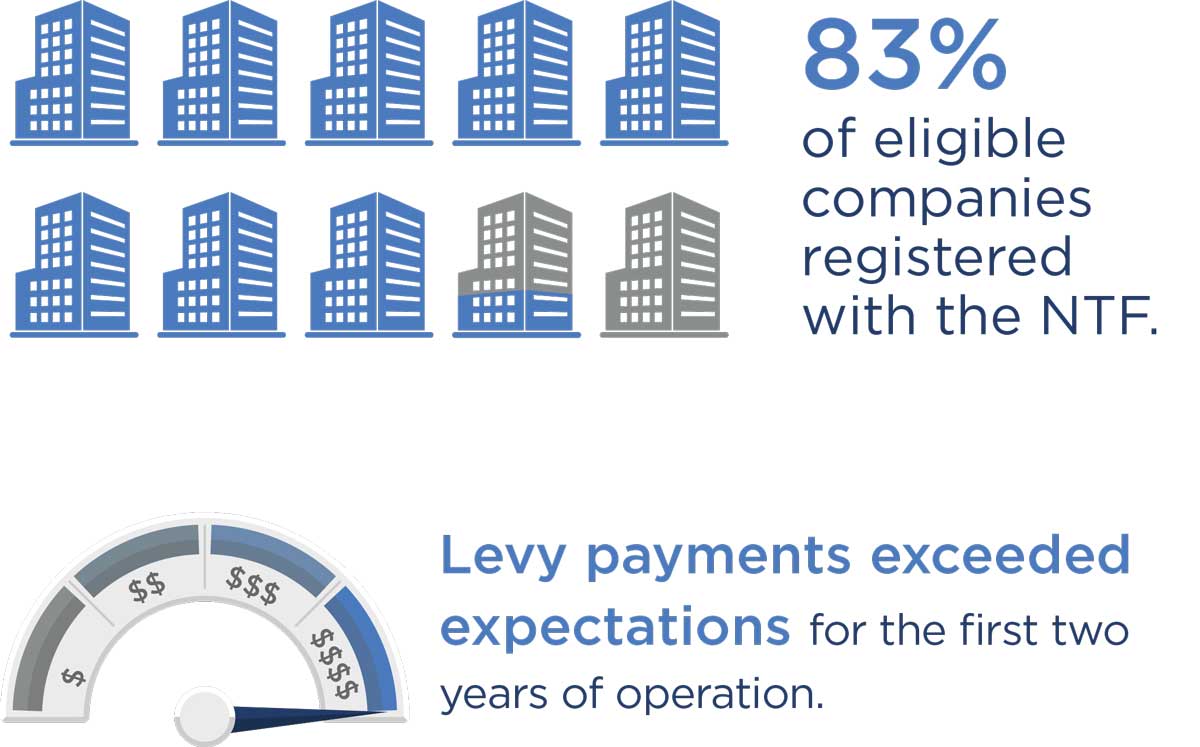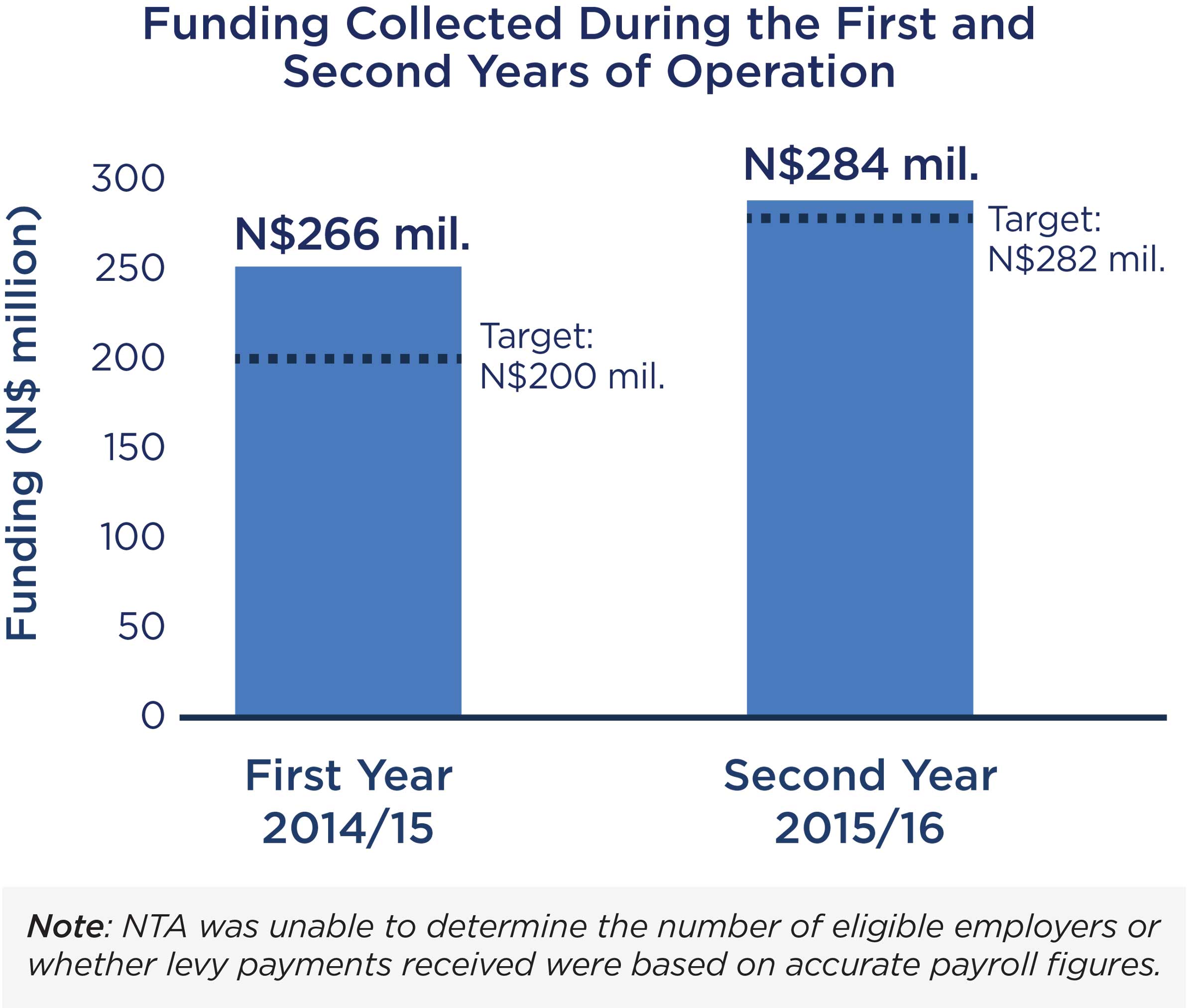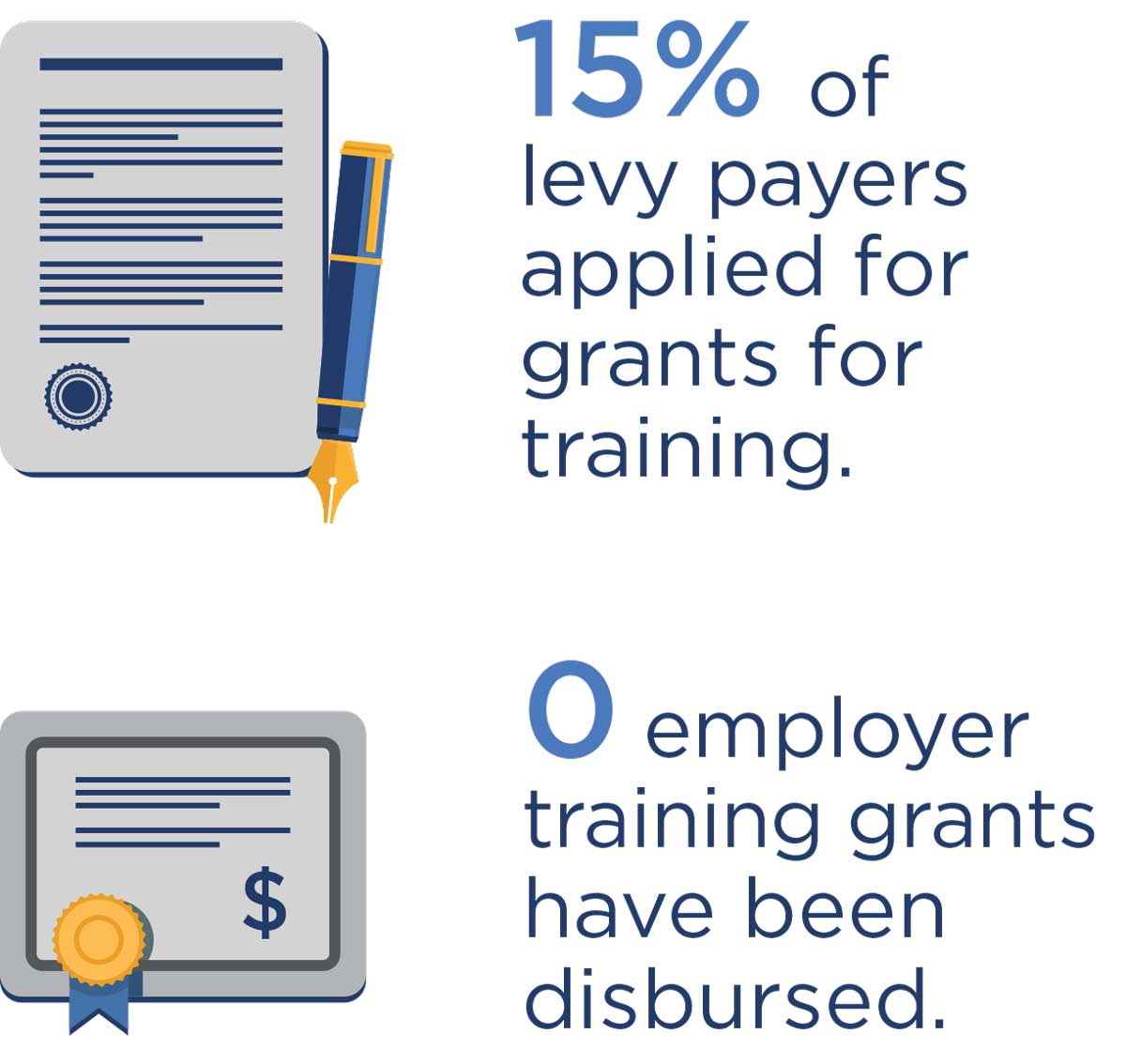Program Overview
MCC’s $295.7 million Namibia Compact (2009-2014) funded the $145 million Education Project, which included the $3.4 million National Training Fund (NTF) Sub-Activity. The program aimed to address the skills gap in Namibia’s labor force by establishing a sustainable source of funding for high-priority vocational education and skills training, thereby better matching workers to the needs of the economy and increasing employment, earnings, and income.
Key Findings
NTF Registration, Payments, and Compliance
- Approximately 83 percent of eligible employers registered with the NTF and made levy payments. Levy payments exceeded expectations by $68 million for the first two years of operation, achieving N$550 million in funding compared to a combined two-year target of N$482 million.
- Compliance was challenging, as reliable data was not available for the Namibia Training Authority (NTA) to determine the actual number of eligible employers or ensure they paid accurate amounts.
Administration Challenges
- All of the administrative structures necessary for NTF functionality and implementation were established, though the levy collection, distribution, and reporting system was not fully operational, as of the time of data collection.
- NTF distributions were limited by the capacity, scope and accreditation status of vocational training providers.
- The NTA was forced to manually process some tasks that should be automated, and general inefficiencies hampered NTF operations.
Future Operations and Sustainability
- While stakeholders viewed the NTF as financially sustainable, there was uncertainty whether the vocational training sector could properly leverage NTF funding.
- Most stakeholders thought it was too soon to tell whether NTF would result in a more skilled workforce, but they remained cautiously optimistic.
Evaluation Questions
This final performance evaluation was designed to explore implementation of the National Training Fund (NTF) operations in the post-compact period, and stakeholder perceptions and expectations about NTF’s prospects for providing skilled labor for the Namibian economy, by answering the following questions:
- 1
Was the establishment of the NTF implemented as planned? - 2
How is the NTF levy collection and distribution system operating in practice, compared with the specifications outlined in the regulatory framework? - 3
What are stakeholders’ perceptions of the sustainability of the NTF?
Detailed Findings
NTF Registration, Payments, and Compliance

The main objective of the NTF Sub-Activity was to help the government of Namibia operationalize a national training fund, which would serve as a sustainable funding source for vocational training in high-priority skill areas. The NTF was managed by the Namibia Training Authority (NTA) and was funded through a payroll-based levy on eligible firms. The Vocational Education and Training (VET) levy regulations required all Namibian employers with a payroll above a threshold of N$1million to register with the NTF and pay an annual levy of 1 percent of their payroll.
Approximately 2,500 of an estimated 3,000 eligible companies (83 percent) registered with the NTF. As a result, N$266 million in funding was collected during the first year of operations, exceeding the target of N$200 million. Following the second year of operations, approximately N$284 million in funding was collected, slightly exceeding the target of N$282 million. However, employer compliance remained a challenge due to the inability of the NTA to determine the total number of eligible employers and whether levy payments received from employers were based on accurate payroll figures.
Administration Challenges
The limited number of accredited training providers and the relatively small total number of qualified training providers in Namibia has restricted full utilization of the NTF. Most providers offered training in the same fields, and it was challenging to procure accredited providers for new and emerging training needs. As a result, while levy fees continue to accumulate, high-priority trainings cannot be procured and employers underutilize grants for employer-sponsored trainings. Only 15 percent of levy payers applied for training grants and, as of data collection, no employer training grants had been disbursed.

The levy collection, distribution, and reporting system (LCDRS) for managing NTF data suffered from a lack of integration and timely implementation, resulting in an inability to integrate information from one internal NTA department to another, and even from one VET levy component to another. Consequently, NTA manually processed some tasks, like report generation, that should be automated, and general inefficiencies hampered NTF operations.
Future Operations and Sustainability
Stakeholders believed that the NTA could do more to help them engage in the NTF process more effectively. For example, communication between the Industry Skills Committee (ISC), the NTA, and employers could be improved. Employers also requested more NTF informational sessions to explain the role and benefits of the levy system. And several employers expressed a desire to give feedback more easily regarding changing industry trends and skill needs, and be more involved in decision-making processes regarding the levy.

A vast majority of the respondents felt that the NTF was sustainable financially and in terms of longer-term management. However, they were uncertain whether the vocational training sector could absorb NTF funding and use it effectively. Concerns included continued compliance with levy regulations, the level of the government’s continued support of the NTA, and the need for NTA to retain and increase relevant staff. Overall, most stakeholders thought it was too soon to tell whether the promise of a more skilled workforce would result from the NTF, but they remained cautiously optimistic.
MCC Learning
Improving the quality and relevance of technical and vocational education and training (TVET) programming requires a package of interventions rooted in the key institutional problems identified in the given context. MCC would benefit from conducting more thorough assessments of the institutions and stakeholders involved in TVET systems in the early stages of compact development.
Interventions to achieve policy reform should build in time for testing new approaches and incorporating lessons learned. The operationalization of the NTF was more complicated than expected at the time of design, requiring additional time and other mid-stream adaptations. Future project design should ensure that work plans are built in realistic amounts of time to enact, test and implement a policy.
Projects need to plan for all conditions necessary to achieve success. The NTF was necessary but not sufficient to bring about a demand-driven vocational training system. Projects need clear logic that accounts for all conditions necessary and sufficient for achieving targeted results, and ensure that implementation decisions are considered within the context of their effect on these results.
Evaluation Methods

Students develop culinary skills as part of the VTGF Sub-Activity, which was meant to build the capacity of the training sector to absorb NTF funding.
The NTF performance evaluation built on a prior round of data collection and analysis conducted in 2014 and primarily draws on qualitative data collected from a variety of sources between October and December 2015; this included 29 in-depth interviews, site visits, and reviews of documents provided by stakeholders and collected from the media. Interviews were conducted with NTA board and NTF council members, employers, ISC members, and other relevant stakeholders.


Dishes prepared by students of the NTF Sub-Activity
The evaluator and data collection subcontractor coded the data and then the evaluator triangulated information from multiple sources. The team identified major themes that emerged from the data related to the research questions above. The resulting analysis accounts for similarities and differences in perspectives across different respondent groups. It also provides a comprehensive picture of the operation and evolution of the NTF.
The exposure period for the evaluation was 13 – 20 months.


